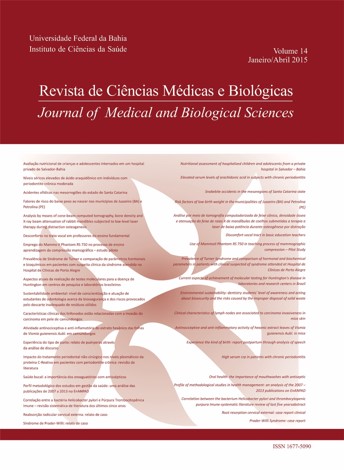Analysis by means of cone-beam computed tomography, bone density and X-ray beam attenuation of rabbit mandibles subjected to low-level laser therapy during distraction osteogenesis
DOI:
https://doi.org/10.9771/cmbio.v14i1.12388Keywords:
Osteogenesis. Distraction. Laser Therapy. Tomography, X-ray Computed. Bone Density.Abstract
Objectives: To assess by means of cone-beam computed tomography (CBCT) the relative bone density of newly formed bone in rabbit mandibles treated with low-level laser therapy (LLLT) during distraction osteogenesis (DO). Methods: Seven rabbits underwent surgical osteotomy and immediate installation of a distractor on the mandible (right side). DO was performed for 10 days, and LLLT (aluminum-gallium-arsenide [AlGaAs] infrared laser, λ 830 nm, 40 mW) was applied during distractor activation (days 4-10). Three rabbits were euthanized at the end of the activation period (day 10, group A), and four at the end of the maturation period (day 20, group B). Quality and quantity of newly formed bone in the distracted area were measured on grayscale images using adjacente untreated areas as controls. Two CBCT images were acquired for each animal (before and after removal of soft tissue) to evaluate the influence of the soft tissue on X-ray beam attenuation. Results: Mean grayscale values in the distracted area were higher in group B rabbits (140.47 vs. 102.55 in group A), indicating greater bone maturation in a short period. Absence of soft tissues during CBCT scanning was associated with higher grayscale values, indicative of less X-ray beam attenuation. Conclusions: It is possible to measure differences in bone density in areas subjected to DO on CBCT scans, providing an objective assessment useful for monitoring bone quality during the repair process.
Downloads
Downloads
Published
How to Cite
Issue
Section
License
The Journal of Medical and Biological Sciences reserves all copyrights of published works, including translations, allowing, however, their subsequent reproduction as transcription, with proper citation of source, through the Creative Commons license. The periodical has free and free access.


